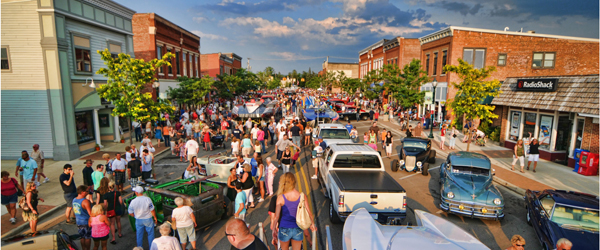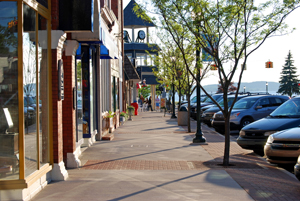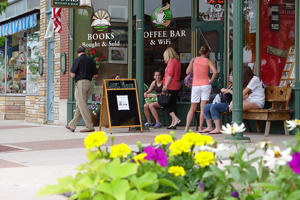How to reinvigorate a stagnant downtown organization and increase business activity and investment.
Inspiration
A small group of volunteers learned of the National Trust for Historic Preservation’s Main Street Approach in the late 1990s. They convinced City and Downtown Development Authority leadership of its value, and a number of community leaders began attending National Trust conferences and learning from large and small Main Street pilot communities around the country. At the same time, they were visiting other downtowns in Michigan, such as Cadillac and Alden, and borrowing the best of what they saw.
Overview
Boyne City Main Street is a volunteer-driven organization led by an appointed board, a full-time Main Street manager, and supportive leadership from community institutions such as the public school system, the Chamber of Commerce and city government. It focuses its efforts around the National Trust for Historic Preservation’s Main Street Four-Point Approach®: promotion, design, organization, and economic restructuring.
Boyne City was one of the first communities to participate in the program under the auspices of the Michigan Main Street Center and it has been one of the most successful—recognized twice as the state’s Main Street of the year, listed in the National Register of Historic Places, and once selected as a Great American Main Street semifinalist. Much of Boyne City’s success is predicated on consistent collaboration between major community organizations such as city government, chamber of commerce, school district and the district library, with financial and technical support from state government agencies.
Accomplishments
- Created successful downtown events such as Stroll the Streets, Boyne Thunder, Holiday Open House, Earlier than the Bird, and the Harvest Festival
- Manage highly successful Farmers Market
- Partnered with city on more than six million dollars in downtown infrastructure investment
- Founded Team Boyne, a local economic development team that has been instrumental in creating a community network of business, government, school and nonprofit organization leaders
- Assisted 12 property owners with façade renovations
- Attracted new restaurants and stores
- Worked with private developer to develop One Water Street, a multimillion dollar complex with restaurant, retail, office and residential uses
- Built a positive environment where residents and visitors alike want to visit, shop, and do business
- Twice recognized as the Michigan Main Street program of the year
- Selected as a Great American Main Street semifinalist
- Listed on the National Register of Historic Places
 Organization
Organization
Main Street is governed by a nine-member board, which is appointed by the City Commission. The Main Street board hires a full-time program manager who receives staff support from the city. The majority of board members must have a business or property interest in the downtown. There are four Main Street committees: Promotion, Design, Organization, and Economic Restructuring (also known as Team Boyne). All committees are staffed by approximately five volunteers. Under some committees there are subcommittees working on specific projects, such as the Farmers Market and the Art Festival.
Budget
Annual budget is approximately $400,000. Total infrastructure investment in the downtown surpassed six million dollars in the first ten years of the program.
Funding
Property tax (tax increment financing), event revenues and sponsorships
Participants
City government, downtown development authority, state government agencies, public school system, chamber of commerce, district library, Northern Lakes Economic Alliance, business owners, and residents.
Actions Taken
- Educate key community leaders – After first learning of the National Trust’s Main Street program in 1999, the city and Downtown Development Authority created a local study group and sent several community leaders to the national conference each for a few years. This built momentum locally, taught the participants about best practices from around the country, and put the city in a strong position to obtain assistance from state agencies.
- Identify a common cause and work together – The list of local organizations supporting Main Street and participating in Team Boyne is impressive. This resulted from leadership of all those entities recognizing that they had a common interest in the success of downtown.
- Solicit support from regional and state organizations – When the State announced it was launching the Michigan Main Street program, Boyne City already had its foot in the door, thanks to relationships it had been building with state agency staff and assistance from the Northern Lakes Economic Alliance. Boyne City was selected in 2003 as one of the first communities to participate in Michigan Main Street.
- Make a fresh start – The Boyne City Downtown Development Authority, like many DDAs, had political and historical baggage from previous efforts. After deciding to launch the Main Street program, the DDA and city decided to clean the slate and
start anew. As Kelly Larson, the first Main Street manager for Boyne City, put it, “If everyone thought this was just more of the same, it had no chance of making a difference.†All the DDA board members voluntarily resigned and a new DDA/Main Street board was appointed from scratch. This allowed old political issues to be put to bed and provided motivation for new people to get involved.
- Decide on the right organizational structure – City and chamber leadership initially wanted to house the program in one of those organizations, but ultimately decided, with guidance from the state’s Main Street program staff, to give it more independence. The city, chamber and other organizations still provide support to the program.
- Go full-time – In 2003, the Main Street board hired its first coordinator. City Manager Michael Cain identifies the decision to hire a full-time, rather than part-time, staff person as a “huge†step. It may be difficult, Cain says, for local governments to cobble together funding for a full-time person, but the return on that investment is worthwhile.
- Find talented volunteers and turn them loose – The Main Street approach is difficult to execute without a deep, dedicated roster of willing volunteers. Larson describes her early months as being full of cold-calling potential participants. She says it was important to identify a mixture of businesspeople and those with other interests in the downtown, so that the organization doesn’t become too single-minded. Main Street has also benefitted from the creativity of the local high school’s television and film students who have developed a number of promotional videos.
- Build buzz with events – The program started out with a very limited budget, so early efforts were focused on low-cost events to increase activity. Stroll the Streets, a Friday evening summer music program, started in 2003.Main Street Coordinator Hugh Conklin describes it as “our signature event†and “hugely successful.†This was followed by Boyne Thunder, an annual boating event that is now a major fundraiser for the program.
- Invest in physical improvements РSuccessful events build momentum and support for increased investment in the physical condition of a place. The Main Street harnessed this momentum by investing in fa̤ade and streetscape improvements and supported businesses increasing their investment in the downtown.
- Celebrate success – Boyne City takes every opportunity to publicly celebrate Main Street successes, including anniversaries, milestones, project launches, and grant awards. This shows the value of the investments that have been made and builds public support for the program.
 Lessons Learned
Lessons Learned
- Increasing activity and improving the physical appearance will catalyze private investments
- Successful small projects lay the groundwork for larger grants, especially if you take them seriously and make state/federal agencies look good
- Welcome fresh ideas from outside the community
- Take informed risks and learn from failures
- It doesn’t matter what the program is if you don’t have the right people to lead it
- A culture of collaboration between key organizations, residents, and businesspeople can persist even in the face of significant personnel turnover
- Take the time to appreciate volunteers and the effort they put forth
- Negative politics take a toll on project results, so stay positive, apolitical and united
- Don’t tackle the big, difficult vacant buildings first—those issues become easier to deal with once you make other small improvements and build positive momentum
- The Main Street approach can strengthen existing downtown organization, even one that’s already strong
- Create a better version of your existing community rather than trying to emulate another place
- Small investments in training and educating key community members can pay off in a big way
Expert
Hugh Conklin, Boyne City Main Street Coordinator, [email protected]
Similar projects
Visit michiganmainstreetcenter.com for a complete list of communities participating in the state’s Main Street program.





 Organization
Organization
 start anew. As Kelly Larson, the first Main Street manager for Boyne City, put it, “If everyone thought this was just more of the same, it had no chance of making a difference.†All the DDA board members voluntarily resigned and a new DDA/Main Street board was appointed from scratch. This allowed old political issues to be put to bed and provided motivation for new people to get involved.
start anew. As Kelly Larson, the first Main Street manager for Boyne City, put it, “If everyone thought this was just more of the same, it had no chance of making a difference.†All the DDA board members voluntarily resigned and a new DDA/Main Street board was appointed from scratch. This allowed old political issues to be put to bed and provided motivation for new people to get involved. Lessons Learned
Lessons Learned